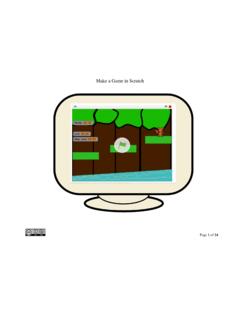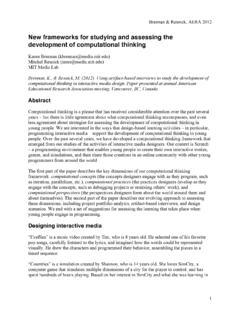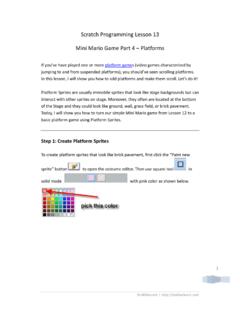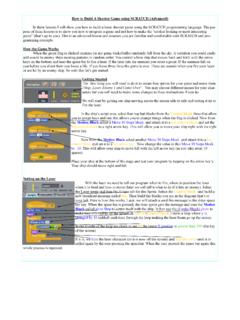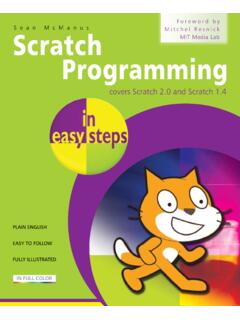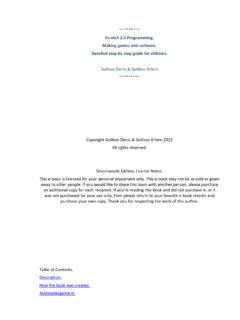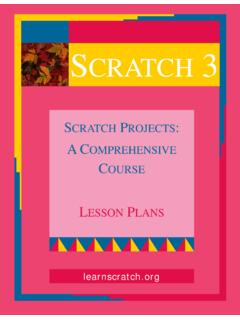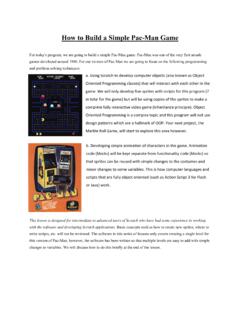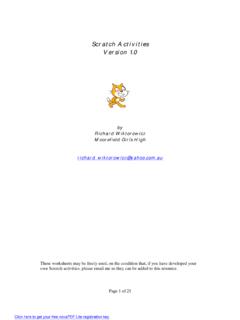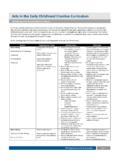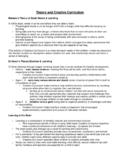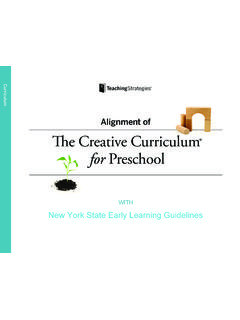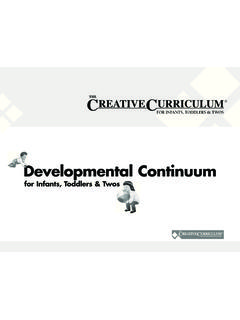Transcription of CREATIVE COMPUTING CURRICULUM GUIDE
1 CREATIVE COMPUTINGCURRICULUM GUIDEa preview of the third editionfrom the ScratchEd Team at the Harvard Graduate School of EducationWELCOME!We are so excited to offer you a sneak peek of the third edition of the CREATIVE COMPUTING CURRICULUM GUIDE often referred to as simply, the GUIDE . The third edition, aligned with the much-anticipated release of Scratch , foregrounds our commitment to student-directed explorations of COMPUTING , and incorporates feedback from educators around the this session, we will showcase our updated approach through the following four stations:STATION 2:CREATESTATION 1:EXPLORESTATION 3:REMIXSTATION 4:ASSESSWalk through an introductory activity in Scratch your assessment values and approachesAdapt an activity to better meet your students needsExperience open-ended project work as a learnerWe hope these activities inspire you on your CREATIVE COMPUTING journey!
2 WHAT IS THE CREATIVE COMPUTING CURRICULUM GUIDE ?The GUIDE is a collection of activities, ideas, and strategies designed to support educators in exploring CREATIVE COMPUTING with their students. Since the release of the first edition in 2011, the GUIDE has been downloaded over 100,000 times, and used by educators across the world. We are thrilled to be a part of this community of educators who strive to foster students creativity, imagination, and interests through CREATIVE questions do you have about CREATIVE COMPUTING ?EXPLOREHOW CAN I SUPPORT CREATIVE COMPUTING ?Whether you are teaching in a K 12 classroom, a library, or a summer camp, you can support CREATIVE COMPUTING by encouraging your students to make projects that are personally meaningful and self-directed!
3 Try visiting all of the stations today to get a more complete picture of CREATIVE COMPUTING in practice. DIVING IN!We designed the following 10 Blocks activity as a way to get started with CREATIVE COMPUTING using the new Scratch interface. Whether you are new to Scratch or an experienced user, we encourage you to engage with this activity as a learner, reflecting on your experience as you CAN YOU CREATE WITH ONLY 10 SCRATCH BLOCKS?Create a project using only the 10 blocks on the following page. Use them once, twice, or multiple times, but try to use each block at least once. Go to the Scratch preview website: START HERE10 BLOCKS Click on the Try It! you are satisfied with your project (or after 10 minutes, whichever comes first), find a partner.
4 First, take turns sharing your projects. When working with students, we adopt a framework of using I , I statements. What did you notice about your partner s project? What does this lead you to wonder about? Now, test ideas by experimenting with each block. Mix and match blocks in various ways. Repeat!SHARINGREFLECTINGWhat experiences have you had with project-based learning in the past?HOW DO I MAKE PROJECTS WITH THE GUIDE ?We designed the GUIDE as a starting point and inspiration for project-based CREATIVE COMPUTING work. The GUIDE contains resources on how to scaffold student learning through one or multiple short- or long-term projects. Resources in the third edition of the GUIDE include materials such as Creativity Catalysts and reflection APPROACH TO PROJECT-BASED LEARNINGT here is no knowing what students will make when they are given a blank canvas we are constantly amazed by the projects we see!
5 We encourage students to develop as computational thinkers by creating personally meaningful open-ended projects, experimenting and tinkering with ideas, and collaborating with others to give and receive IN!We designed the following Mini-Project activity as an example of what open-ended projects with Scratch can look and feel like as a learner. We encourage you to create a project that interests you, while also reflecting on your experience throughout the activity is split into four parts, each requiring about 15 minutes to complete. We recommend starting with only the first part of this activity and returning if you have time, after exploring other stations. However, if you get excited by your project, please stay and continue working!
6 Think of a project you would like to make. If you are struggling, turn the page to try out one of the Creativity Catalysts for inspiration. Create a high-level plan for your project using any or all of the following prompts:WHAT KIND OF PROJECT WOULD YOU LIKE TO MAKE?In this activity, you will develop an open-ended project to work on in HEREMINI PROJECTPART ONE: PLANWhat is your interesting idea? What would it look like if you took this idea and made it in Scratch?Would it be a game? A story? A puzzle? A music video? Something else entirely?What resources ( , people, sample projects) might you have or need to develop your project?What is the first step you would take?MEET ARI THE PUFFERFISH.
7 WHAT DOES ARI DO DURING THE DAY?CREATIVITY CATALYSTC ircle something on your page that you think is interesting. Make your Scratch project about this!1. 2. 3. 4. 5. 6. 7. 8. 9. 10. WRITE DOWN 10 QUESTIONS YOU HAVE ABOUT ANYTHING!CREATIVITY CATALYSTC ircle a question on your page that you think is interesting. Use your Scratch project to answer this question!PART TWO: DRAFTPART THREE: SHAREPART FOUR: REVISE Navigate to Spend 10 minutes making a first draft of your project. It does not need to be perfect, or even work as intended just make anything! Find a partner and take turns sharing your projects. Briefly describe the big idea for your project, and then what your project currently does.
8 Share one thing you are struggling with or wondering about in your project. Ask your partner for any feedback. Listen as your partner shares their project, and provide thoughts and feedback. After sharing with a partner, and receiving feedback, try to imagine how you could incorporate that feedback into your project. Consider the following questions:What do you like about your project so far?What would you like to change about your project?How has the feedback you received influenced your idea for your project?What is the next step you would like to take with your project?REFLECTINGWhen have you changed an activity to meet your students needs better? In what ways did you change it?
9 REMIXHOW DO I REMIX THE GUIDE ?No matter your prior experience or expertise with COMPUTING , every educator is a co-designer of the CREATIVE COMPUTING experience. Educators remix the GUIDE by changing the timing of activities, integrating curricular content ( , poetry, algebra), or adjusting the language to meet students vocabulary levels. You can change anything you want! WHAT IS REMIXING?Remixing means taking something that already exists and adapting it to make it your own. Using chocolate chips instead of the raisins in your cookie recipe? That s remixing! Reusing a fellow Scratcher s score-keeping code in your new World Cup-inspired game? That s remixing! Expanding the scope of an activity to include content from another subject?
10 Yep, that s remixing too!DIVING IN!We designed the following Activity Adaptation station to give you an opportunity to practice remixing activities from the GUIDE to suit your needs. This is an opportunity to make your ideal version of an CAN YOU CHANGE AN ACTIVITY TO BETTER MEET YOUR STUDENTS NEEDS? Find a partner who teaches the same subject, age/grade level, geographic region, or environment as you. Turn the page to find the About Me activity. Working with your partner, think about the questions on this page, and write down how you would change the About Me activity. When you re ready, mark up the activity with your changes!START HEREACTIVITY ADAPTATIONPROMPTSWhat do you like about the About Me activity?
